Exam 2
1/36
There's no tags or description
Looks like no tags are added yet.
Name | Mastery | Learn | Test | Matching | Spaced |
|---|
No study sessions yet.
37 Terms
What are the stages of gonadotropin dependence in the follicular growth?
Gonadotropin independent
Gonadotropin responsive
Gonadotropin dependent
Gonadotropin independent
Initial development occurs
independent of gonadotropins. Species vary in how advanced follicles can grow independent of gonadotropins.
Gonadotropin responsive
follicles can respond to gonadotropins but gonadotropin stimulus is not required for follicle growth
Gonadotropin dependent
follicles have been stimulated to grow towards ovulation, removal of gonadotropins results in atresia
What are the stages of a follicular wave?
Recruitment (cyclic)
Selection
Dominance
Follicular Wave Recruitment
A group of small antral follicles initiate growth following release of previously dominant follicle and an increase in FSH
Fate: selected for continued growth or become atretic, atresia.
Follicular wave selection
From recruited pool, one follicle will be selected for continued growth
At selection, conc. of FSH have decreased, in response to - feedback of estradiol and inhibin from group of recruited follicles.
As selected follicle becomes dominant, it become dependent upon LH
Follicular wave Dominance:
Selected follicles become dominant follicles
Dom. Follicle secretes lots of estradiol and inhibin which keeps FSH low
Low FSH prevents recruitment of the next wave
How does ovulation occur?
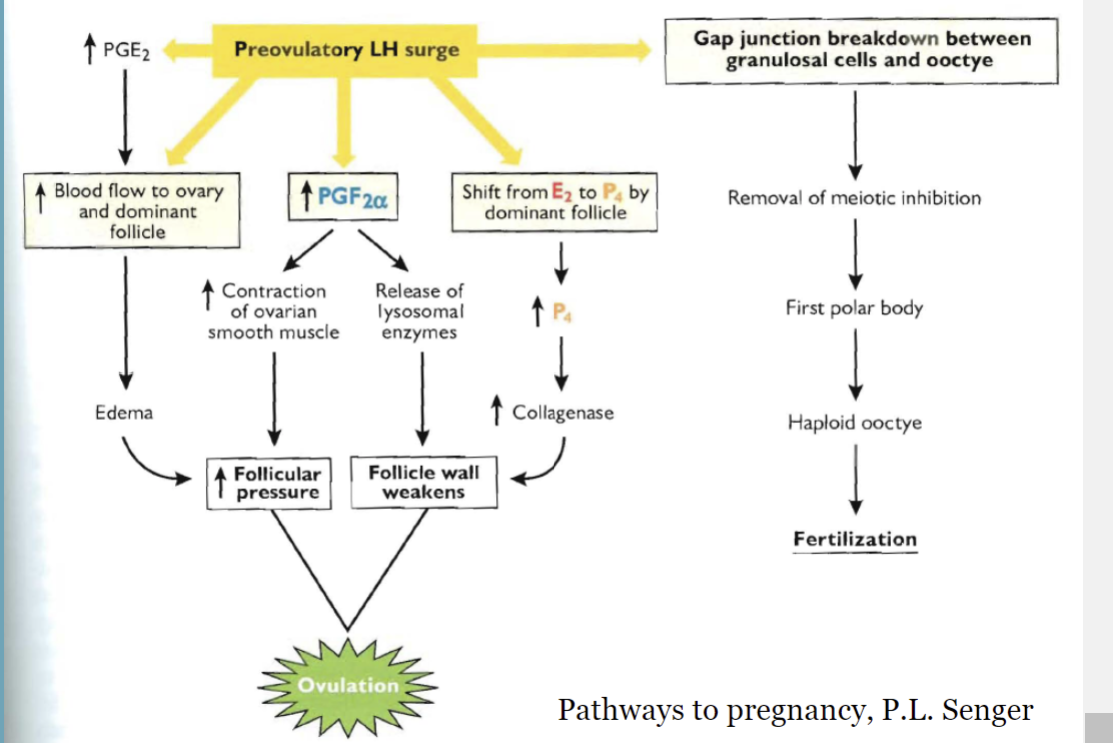
What are the different types of reproductive cycles?
Polyestrous
Seasonally polyestrous
Monoestrus
Reproductive Cyclicity: Polyestrus
Cattle, swine, rodents, domestic cats
Uniform and regular cycles throughout year
pregnancy opportunities year-round
Reproductive Cyclicity: Seasonally polyestrous
Sheep, goats, horses, deer, elk, wild cats
Clusters of cycles only during certain season of year (can artificially manage using light during winter)
Short day breeders vs long-day breeders
Short:
Sheep, goat, elk, deer
Start cycles when day length decreases
Long-day breeder
horses, wild cats
start cycles when day length increases
Reproductive Cyclicity: Monoestrus
dogs, wolves, fox, bear
One cycle per year
duration of estus: several days
domestic canine: typically 3 cycles in two years
What are the phases of the estrous cycle and its associated hormones?
Follicular phase
growing follicles + estrogen dominance
Luteal Phase
corpus luteum + progesterone dominance
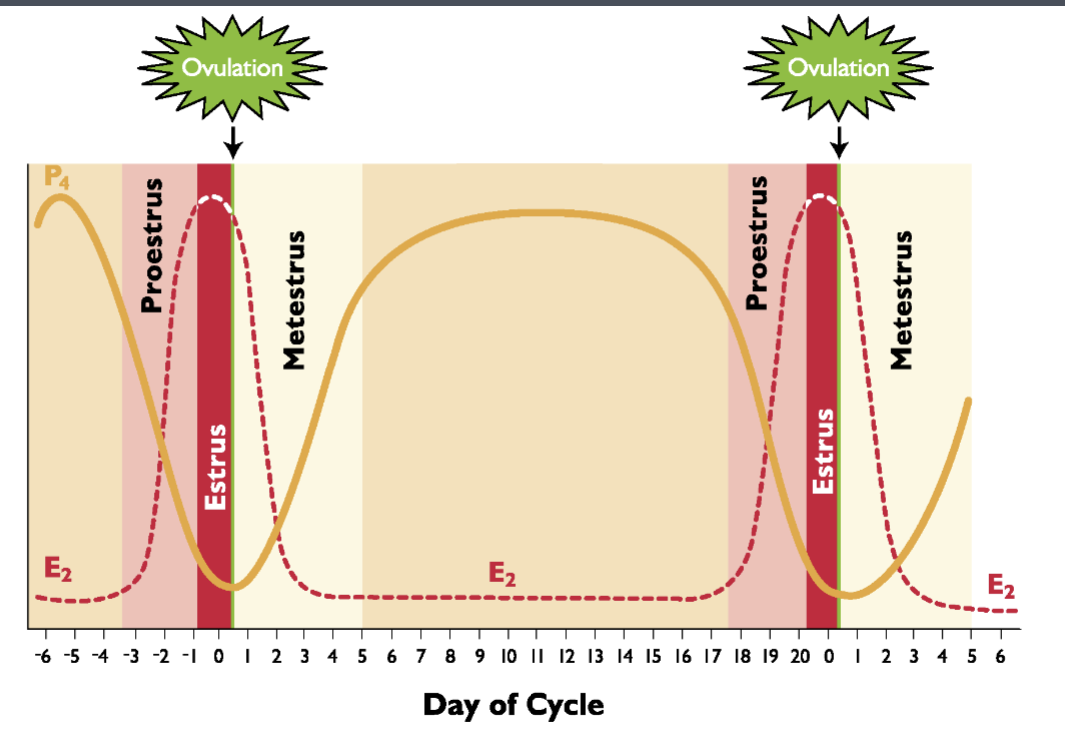
Follicle phase
Proestrus
transition: progesterone to estrogen dominance
Formation of ovulatory follicles. Increase estrogen secretion (FSH/LH primary hormones)
Estrus:
Estrogen drives behavioral estrus
Sexual receptivity + peak estrogen + LH surge + Ovulation
Luteal Phase
Metestrus (period between ovulation and initial CL formation)
luteinization of ovulated follicle
Estrogen and progesterone are low
Diestrus
CL fully functional with sustained progesterone (+LH)
Higher progesterone prepares uterus for pregnancy
non-pregnant → luteolysis (uterine PGF2a)
What are the difference between cow and human cycles?
Cow:
begins and ends with estrus/ovulation
follicular phase is short
luteal phase dominates
Starts with ovulation
Human:
follicular and luteal phases are the same length
ovulation occurs in the middle of the cycle
cycle begins and ends with menses
What is the estrous cycle in a female dog like?
Anestrus (5 months long)
Proestrus (9 d)
Estrus (9)
Diestrus (2 months)
Estrous cycles in female cat
In estrus = no mating
Female in constant follicular phase
induced ovulators, copulation needed to induce LH surge
(no true luteal phase)
Estrus cycle: 17
Estrus: 9 d
Estrus to ovulation: 30-40 hrs
Define Anestrus. What are the different anestrus types?
Definition: period without regular estrous cycles (temporary)
Non-physiological
inadequate nutrition
stressful environment
pathologic conditions
Types:
Gestational
Lactation
Seasonal
Gestational Anestrus
Negative feed-back from progesterone
end of gestation (species specific)
Lactation Anestrus
Species-specific
Negative feedback from suckling
Seasonal Anestrus
Evolutionary: driven by environment/nutritional conditions
Photoperiod and temperature
short day breeders
long day breeders
Oocyte pick up and transport to site of fertilization
Picking up the oocyte from the surface of the ovary or from the ovarian bursa by the fimbria
mesosalpinx contracts rhythmically during ovulation, causing the fimbria to slide over the surface of the ovary
Transport of the oocyte through the oviductal ampulla
Smooth muscle in the broad ligament move the oviduct and ovary to aid in the positioning of the fimbria over the ovary
What are the types of sperm transport to the site of fertilization?
Swimming Movements
Contraction of SM via prostaglandins (PGF2a PDE2)
Movement of fluids
Sperm loss in the reproductive tract
Retrograde Loss:
semen leak out of vaginal canal via contractions
phagocytosis-
death of sperm within female repro
what are the Sperm Capacitation and fertilization processes?
Capacitation: change sperm undergo in the female reproductive tract that enables them to penetrate and fertilize an egg.
Fertilization: hyperactive motility → binding to zona pellucida → acrosome reaction → penetration of zona pellucida → sperm-oocyte membrane fusion → release of 2nd polar body → sperm engulfed → decondensation of sperm nucleus → formation of male pronucleus
What are the methods used to block polyspermy (fertilization of multiple sperm to one oocyte)?
Zona block: (cow, pig, rats/mice) Zona pellucida hardens (like hardening concrete), runner-up sperm that have no finished traversing the zona pellucida by the time of hardening are stopped in their tracks
Vitelline block: (rabbit, rats, mice) sperm receptors in the zona pellucida are destroyed. Therefore, any sperm that have not yet bound to the zona pellucida will no longer be able to bind or fertilize egg.
Cortical Reaction
cortical granuals released on outside of cell modifies extracellular barrier to block sperm
Explain the resumption of meiosis and pronucleus formation
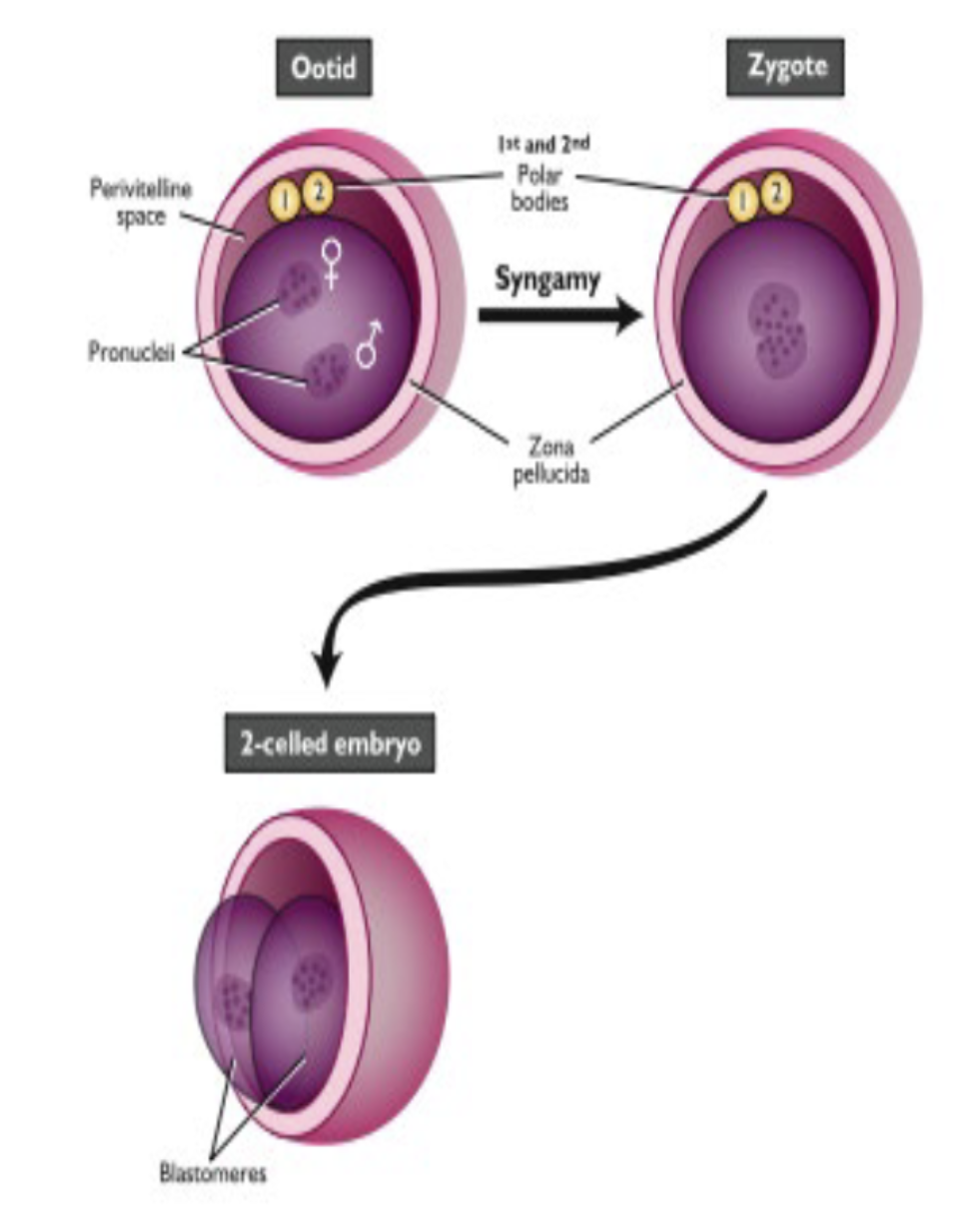
Explain the physical changes in the embryo from zygote to the blastocyst stage
Zygote: single-cell embryo that eventually divides → cleavage (increase cell # w/out increases cells mass) → forms blastomeres → blastocyst is a bunch of cells clumped together to form two cell populations → inner cell mass (embryo proper) and trophoblast (chorion (outer placental layer))
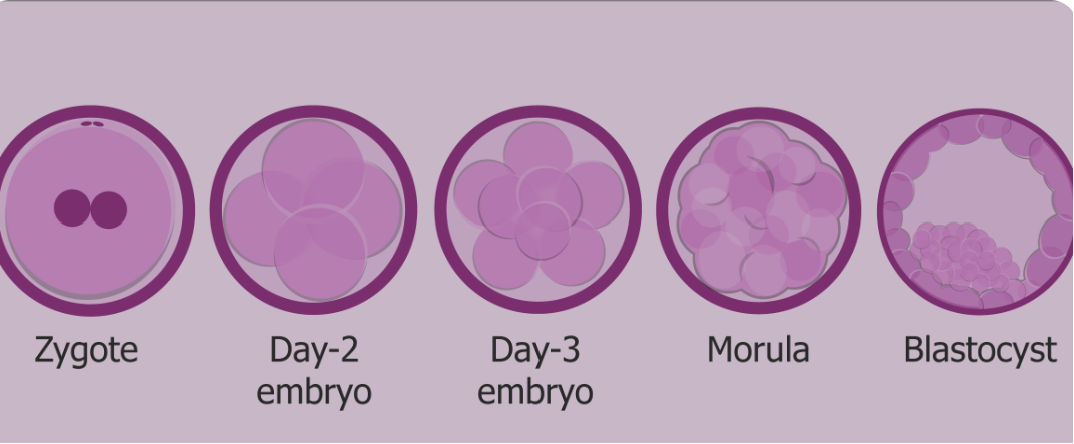
What is the importance of compaction?
Compaction def: maximizes intercellular contact and results in the formation of the morula (tight junction)
Before: free movement of molecules across embryo
After: polarized cell, environment different on each side of tight junction. Cells forming inside and outside of tight junction will have different fates
How is the blastocyst formed?
inner cell mass = fetus
Trophectoderm= placenta
Blastocoel cavity = cavitation
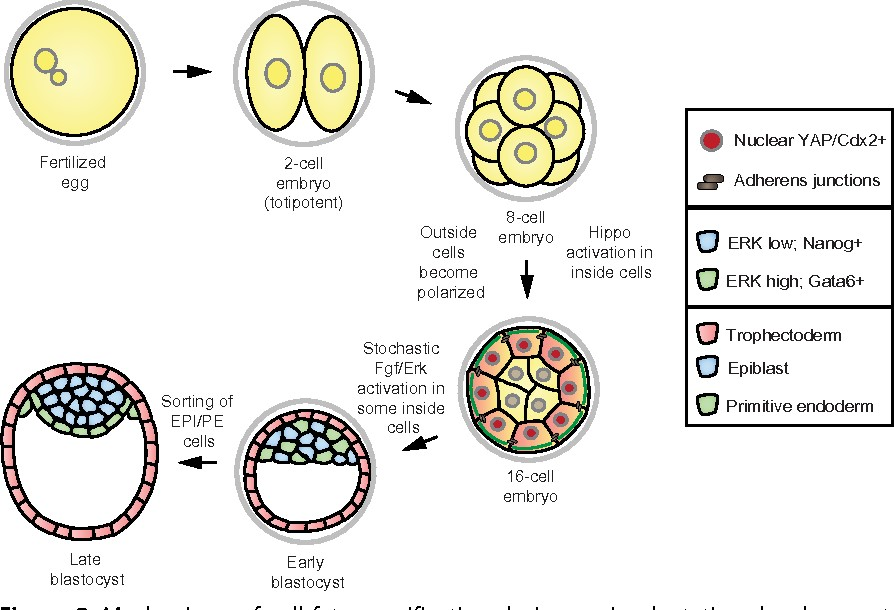
What is the embryo metabolism during preimplantation development?
The oocyte in the beginning uses glycolysis (energy source) and PPP → Polyol pathway provides other sources of energy → after fertilization, the zygote depends on tricarboxylic acids (pyruvate and lactate) as energy sources.
What is the maternal to embryonic transition? (genome activation)
As the cell goes from oocyte to blastocyst, it slowly goes from transcript origin of maternal to more of a transcript origin of embryonic.
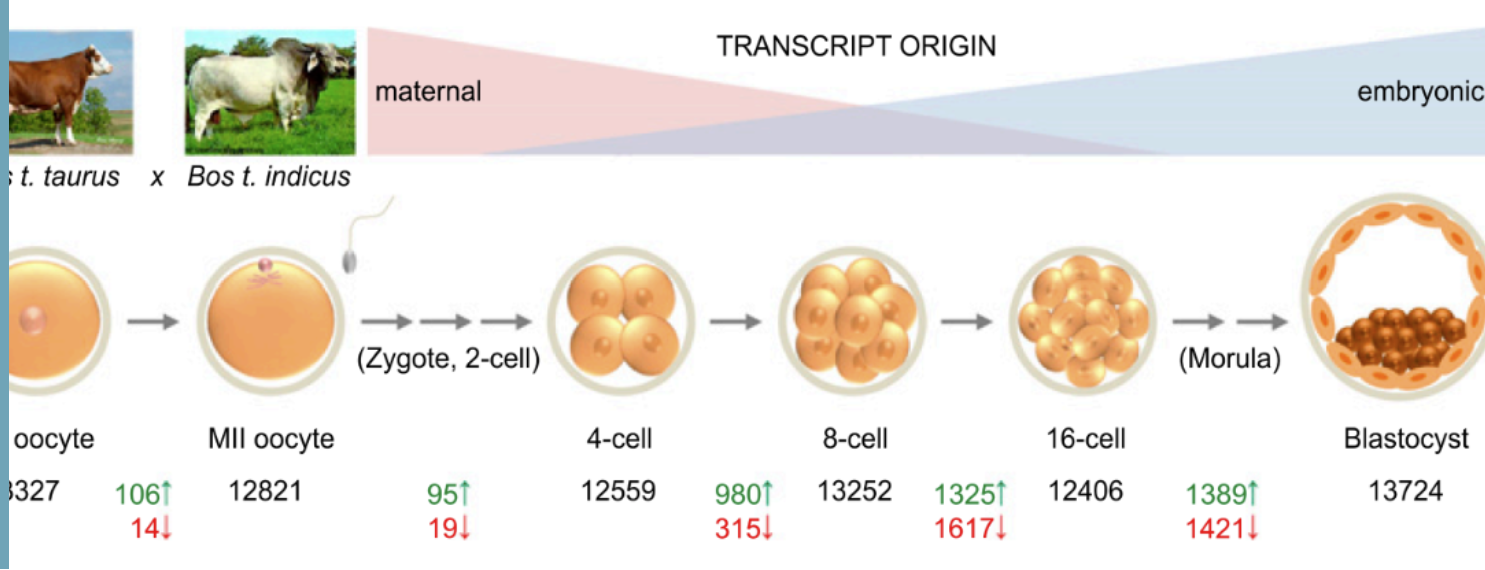
What happens to the embryo after it hatches from the zona pellucida?
Result of several forces to degenerate zona. Blastocyst growth and fluid accumulation increases the pressure. Enzyme production by trophoblastic cells weakens zona, blastocyst contraction causes intermittent pressure pulses.
Post hatching: blastocyst is free floating in uterus. dependent on uterine environment for survival. Adequate luteal progesterone increases uterine secretions
ovulation cycle